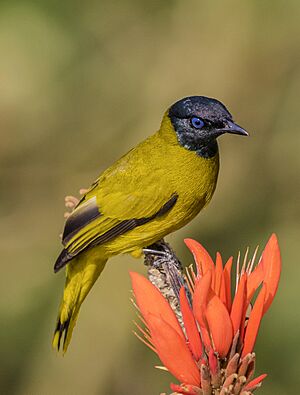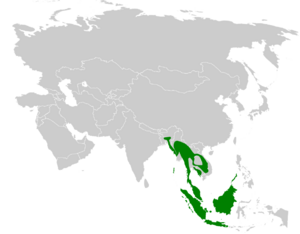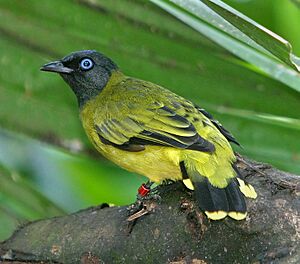Black-headed bulbul facts for kids
Quick facts for kids Black-headed bulbul |
|
|---|---|
 |
|
| In Bangladesh | |
| Conservation status | |
| Scientific classification | |
| Genus: |
Brachypodius
|
| Species: |
melanocephalos
|
 |
|
| Synonyms | |
|
|
The black-headed bulbul (Brachypodius melanocephalos) is a cool bird that belongs to the bulbul family. You can find these birds living in the forests of Southeast Asia.
Contents
About the Black-Headed Bulbul
How Scientists Name Birds
Scientists give every animal a special two-part name, like a first and last name. This helps everyone know exactly which animal they are talking about. The black-headed bulbul got its first scientific name in 1788 from a German scientist named Johann Friedrich Gmelin. He called it Lanius melanocephalos. The name melanocephalos comes from ancient Greek words meaning "black" and "headed."
For a while, scientists thought this bird belonged to a different group called Pycnonotus. But after more study, they moved it to the Brachypodius group in 2018. This shows how science is always learning new things!
Different Types of Black-Headed Bulbuls
Just like people can have different family groups, birds can have different "subspecies." These are slightly different versions of the same bird, often found in different places. There are four known subspecies of the black-headed bulbul:
- B. m. melanocephalos: Found from northeastern India and Bangladesh all the way through Southeast Asia to the Philippines.
- B. m. hyperemnus: Lives on islands off western Sumatra.
- B. m. baweanus: Found on Bawean Island, which is north of Java.
- B. m. hodiernus: Lives on Maratua Island, off eastern Borneo.
What Does It Look Like?
The black-headed bulbul is about 16 to 18 centimeters (about 6 to 7 inches) long. It weighs between 20 and 30 grams, which is about as much as a few quarters.
Most of these birds are bright olive-yellow. They have a shiny, bluish-black head that looks very striking. Sometimes, you might see a rare grey version where the yellow is replaced by grey.
This bird looks a bit like the black-crested bulbul. But the black-headed bulbul has blue eyes and a wide yellow tip on its tail. It also doesn't have a crest, which is a tuft of feathers on its head.
How It Lives
Black-headed bulbuls mainly eat small fruits and berries. They also like to snack on insects. You'll often see them flying around in small groups, usually with about 6 to 8 birds together.



